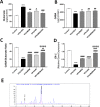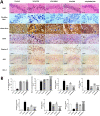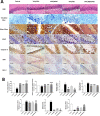Memantine/Aripiprazole Combination Alleviates Cognitive Dysfunction in Valproic Acid Rat Model of Autism: Hippocampal CREB/BDNF Signaling and Glutamate Homeostasis
- PMID: 36918475
- PMCID: PMC10121975
- DOI: 10.1007/s13311-023-01360-w
Memantine/Aripiprazole Combination Alleviates Cognitive Dysfunction in Valproic Acid Rat Model of Autism: Hippocampal CREB/BDNF Signaling and Glutamate Homeostasis
Abstract
Significant efforts are increasingly directed towards identifying novel therapeutic targets for autism spectrum disorder (ASD) with a rising role of aberrant glutamatergic transmission in the pathogenesis of ASD-associated cellular and behavioral deficits. This study aimed at investigating the role of chronic memantine (20 mg/kg/day) and aripiprazole (3 mg/kg/day) combination therapy in the management of prenatal sodium valproate (VPA)-induced autistic-like/cognitive deficits in male Wistar rats. Pregnant female rats received a single intraperitoneal injection of VPA (600 mg/kg) to induce autistic-like behaviors in their offspring. Prenatal VPA induced autistic-like symptoms (decreased social interaction and the appearance of stereotyped behavior) with deficits in spatial learning (in Morris water maze) and cognitive flexibility (in the attentional set-shifting task) in addition to decreased hippocampal protein levels of phosphorylated cAMP response element-binding protein (p-CREB), brain-derived neurotrophic factor (BDNF), and gene expression of glutamate transporter-1 (Glt-1) with a decline in GABA/glutamate ratio (both measured by HPLC). These were accompanied by the appearance of numerous neurofibrillary tangles (NFTs) with enhanced apoptosis in hippocampal sections. Memantine/aripiprazole combination increased the protein levels of p-CREB, BDNF, and Glt-1 gene expression with restoration of GABA/glutamate balance, attenuation of VPA-induced neurodegenerative changes and autistic-like symptoms, and improvement of cognitive performance. This study draws attention to the favorable cognitive effects of memantine/aripiprazole combination in autistic subjects which could be mediated via enhancing CREB/BDNF signaling with increased expression of astrocytic Glt-1 and restoration of GABA/glutamate balance, leading to inhibition of hippocampal NFTs formation and neuronal apoptosis.
Keywords: Aripiprazole; Astrocyte; Autism spectrum disorder; Cognitive dysfunction; Glutamate; Memantine.
© 2023. The Author(s).
Figures








References
-
- Diagnostic and statistical manual of mental disorders: DSM-5. 5th ed., American Psychiatric Association, 2013. Washington, DC.
-
- Centers for Disease Control and Prevention. Key findings: CDC releases first estimates of the number of adults living with autism spectrum disorder in the United States. Available at: https://www.cdc.gov/ncbddd/autism/features/adults-living-with-autism-spe.... Accessed 31 Jan 2023.

